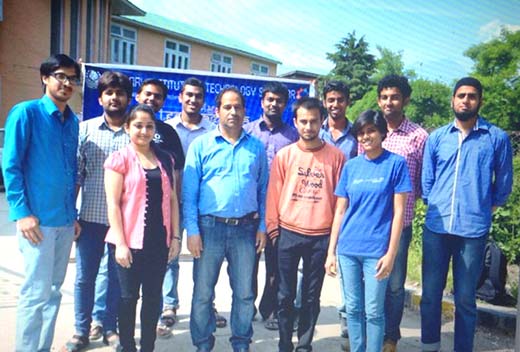This year’s NIT tech fest saw young students putting their brains together to find solutions to everyday issues like traffic, clean water, transportation. Saima Rashid and Sheikh Tabish report the innovations

Pic: Sheikh Tabish
Jahangir Chowk in summer capital Srinagar often turns in to a mess due to loads of vehicles at drive. The very four way road at place is linked to Lal Chowk, Airport, High Court, Batamaloo and Old Secretariat. While the frequent traffic jam at the place often irks the passengers, the same motivated two engineering students of National Institute of Technology (NIT) Srinagar to throw an innovative solution for the persistent problem.
Vakas Hussain and Khalid Manzoor, both 6th semester civil engineering students at the campus have come up with ‘Intersection Model’ that makes use of medians and rotary design to streamline the traffic flow. “Look, it will be a bit time consuming process to drive one’s vehicle around the rotary,” says Manzoor, “but it will altogether reduce the vehicular traffic. And yes, widening of roads instead will consume a lot of money comparatively.”
The duo’s model comprises of the junction made up of the motorway sections, that diverts traffic flow: two-way traffic on Indira Gandhi road from Jahangir Chowk via Solina (four-lane divided carriage way); two-way traffic on Jahangir Chowk-Batmaloo/Qamarwari road (four-lane divided carriage way); two-way traffic on Jahangir Chowk-Shaheed Gunj Road (two-lane divided carriage way); two-way traffic Jahangir Chowk-Budshah chowk road (two-lane divided carriage way) and two-way traffic on Jahangir chowk-Amira Kadal/HSHS road (two-lane single carriageway).
“If implemented seriously, our model would surely end the frequent traffic menace,” Hussain claims.
Filter the Litter
Valley’s countryside localities often face problems owing to water scarcity and impurity. And what adds to their woes is that an average person cannot afford the water purifiers. Heeding to an old adage: Necessity is the mother of innovation; three NITians have come up with a model that can ‘filter the litter’.
Krishna Kumar, Pankaj Kumar and Sandeep Kumar, a trio studying civil engineering have designed: economical, reliable and efficient gradation curve to filter the water.
The trio made a sand filter that can clean up translucent water and turn it transparent. “It filters water at the fastest rate,” says Sandeep. “The translucent water used for testing contains non-toxic and inorganic impurities.” The trio believe that their model will pave a way for the larger benefit of the people living at fringes.
Bridging the gorge
Bridges are one of the most useful and magnificent structures of the modern civilisation. With ever-improving designs, bridges carry loads of immense magnitude and nature and are also expected to handle incidental loads due to natural gorges.
Muhammad Sakib and Sandeep Verma, 6th semester students of civil engineering department have come up with an innovation which can reduce the tension on one of weak sides of bridge and transfer the tension to the strong side. Moreover, the cables balancing the bridge will rescue the bridge to breakdown.
Cheme-Cars
Apart from industries and factories, major source of pollution is reportedly vehicles. Driven by the sense to put check on the obnoxious vehicular emissions, NITians have come up with an important innovation, Cheme-Cars. It involves the designing of an eco-friendly prototype car and has the ability to attain a maximum velocity. The model involves no use of mechanical device to accelerate the car.
The platform
Most of these innovations were at display at the recently concluded TECHVAGANZA 2014 at NIT Srinagar. The annual tech-fest that started in 2009 saw participations of students from the top engineering colleges across India.
Dianne F Bracken, a lady from California who participated in this tech-fest, rates the event ‘very special’. “It is really amazing to interact with such innovative and brilliant students,” she said. “But yes, lack of infrastructure disappointed me.”
“My students always come up with something innovative and new,” says Prof Rajat Gupta, Director NIT. “They [Students] remain all the time busy to innovate something beneficial for the humanity.”
The tech-fest might be over, but the innovators at NIT are upbeat to put their brains at work—so that the next year, they would come up with some more fascinating innovations. It seems creative cravings for novelty has indeed hit the campus.















